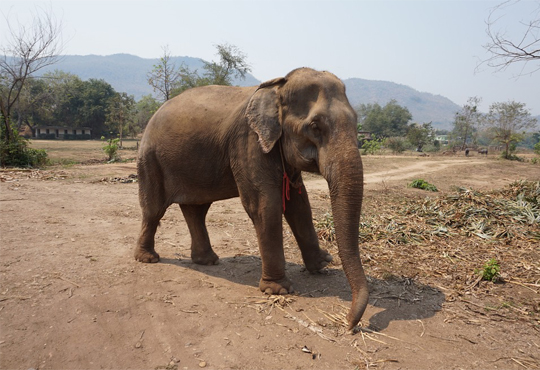
The first elephant I met in Thailand, venturing nervously into a wild animal’s enclosure and fairly sure I was going to die, was called Nam Chok. Back then, there were seven elephant residents at the rescue centre where I volunteered, and the day after my fifteen hour flight and hour long drive I was thrown right in. The centre didn’t believe in making things easy for the human volunteers and quite rightly so; they exist to rescue and care for animals. So I was given the most wilful, unpredictable, newest and fastest elephant they had.
My team leader had a certain love for that stroppy old lady, so she presented Nam Chok in the perfect light. She told me that I needed to be careful, watchful and on guard every time I was in that enclosure, but Nam Chok would make my life interesting and colourful during my month long stay. That promise was fulfilled. When we took her on her daily walks she went where she wanted when she wanted to. This did result in some hairy moments, such as when a local woman stood in our path with nothing but at tiny moped between her and the elephant that swept towards her with deadly intent.
That’s what I love about Nam Chok, her rejection of any tameness that was forced on her throughout her long life. She was in her late fifties, had been a logging elephant, a trekking elephant, and had her spirit broken when she was a calf as all working elephants do. When she came to the centre she was emaciated, scarred and desperately ill. But three months later when I met her, Nam Chok was making her own rules.
She decided who was allowed into her enclosure and who wasn’t. Only one mahout, or elephant keeper, was safe with her and the others were given various levels of toleration. The youngest was so hated that he couldn’t even sit on the fence of Nam Chok’s enclosure without her charging at him, and another refused to re-enter after she smacked him straight off his feet. On my first day when we were giving Nam Chok her daily shower, the male volunteer I was working with stood up on the water bowl in order to clear the mud from the top of Nam Chok’s head. She pushed him off. He tried only once more and got pushed off again, then gave up. It was only later that I realised how gentle that elephant’s rejection was; if she’d wanted to, she could have sent him flying across the enclosure.
Over fifty years of a terrible life didn’t break Nam Chok’s spirit, but sadly it did break her body. It’s hard to fatten up an elephant quickly, and a few months after I left the centre that fiery, stroppy and wilful elephant passed away. I know this isn’t the happy ending her story deserves, that she should have lived many more years eating all the banana trees she could find and terrifying all the people who worked with her. But I am thankful that she was rescued at all, and that I had the privilege of giving her a happy and safe retirement at the end of her life.






